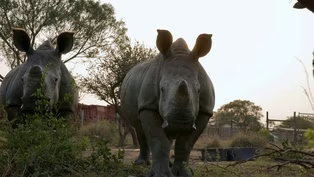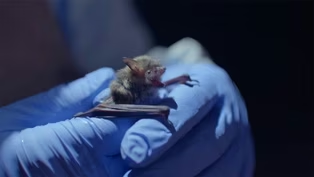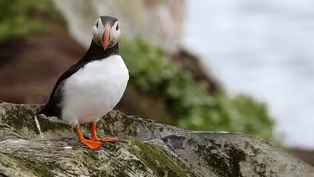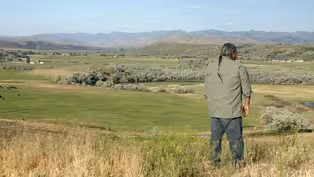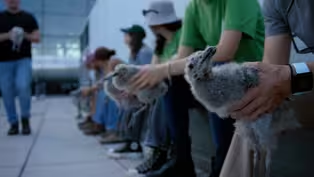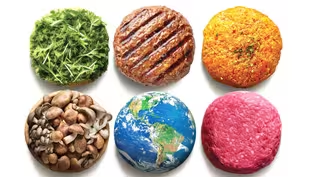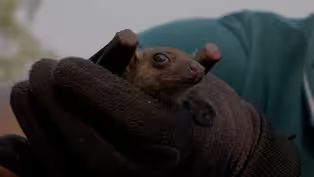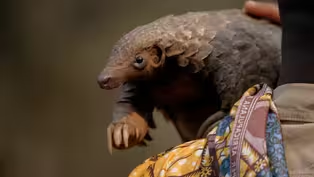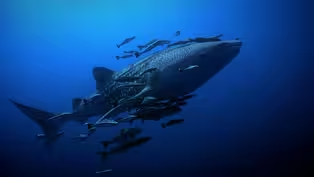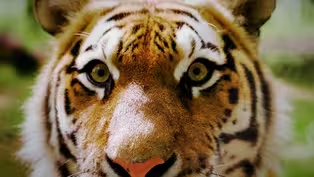
Thunder & Fire | WILD HOPE
Special | 18m 52sVideo has Closed Captions
Sixty million American bison once thundered across the prairies of North America.
Sixty million American bison, commonly known as buffalo, once thundered across the prairies of North America until 1889, when they were almost driven to extinction.
Problems playing video? | Closed Captioning Feedback
Problems playing video? | Closed Captioning Feedback
Major support for NATURE is provided by The Arnhold Family in memory of Henry and Clarisse Arnhold, Sue and Edgar Wachenheim III, The Fairweather Foundation, Charles Rosenblum, Kathy Chiao and...

Thunder & Fire | WILD HOPE
Special | 18m 52sVideo has Closed Captions
Sixty million American bison, commonly known as buffalo, once thundered across the prairies of North America until 1889, when they were almost driven to extinction.
Problems playing video? | Closed Captioning Feedback
How to Watch Nature
Nature is available to stream on pbs.org and the free PBS App, available on iPhone, Apple TV, Android TV, Android smartphones, Amazon Fire TV, Amazon Fire Tablet, Roku, Samsung Smart TV, and Vizio.
Buy Now
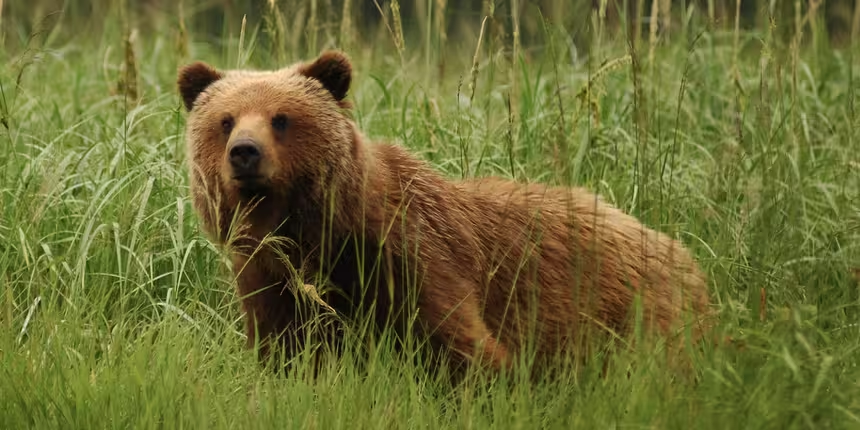
Explore More Ways to Watch
Bring the beauty and wonders of wildlife and natural history into your home with classic NATURE episodes.Providing Support for PBS.org
Learn Moreabout PBS online sponsorshipMore from This Collection
WILD HOPE is a new series of short films that highlights the intrepid changemakers who are restoring our wild places and sparking new hope for the future of our planet.
Video has Closed Captions
How does a densely populated nation like Singapore transform into a lush green oasis? (14m 51s)
Video has Closed Captions
For decades, rhinos have been the face of poaching. (16m 28s)
Video has Closed Captions
As a deadly fungus devastates North America’s bats, scientists are testing new ways to save them. (14m 47s)
Video has Closed Captions
In the Westman Islands, one community has banded together to save lost young puffins. (13m 15s)
Reclaiming Bear River | WILD HOPE
Video has Closed Captions
The Bear River was once a lush area with wetlands, hot springs, and abundant wildlife. (17m 25s)
Building for Birds | WILD HOPE
Video has Closed Captions
Millions of migrating birds pass through our yards, but glass windows pose a deadly threat. (16m 3s)
Mission Impossible | WILD HOPE
Video has Closed Captions
Meet the genius behind the plant-based Impossible Burger. (39m 41s)
Pangolin Protectors | WILD HOPE
Video has Closed Captions
Due to the demand for their scales, pangolins are the most trafficked animal in the world. (12m 24s)
Way of the Elephants | WILD HOPE
Video has Closed Captions
Elephant migration corridors in India are a necessary thoroughfare for one of the largest animals. (15m 11s)
Whale Shark Homecoming | WILD HOPE
Video has Closed Captions
A renowned spiritual leader is inspiring fishermen to become guardians of the world’s biggest fish. (16m 49s)
Video has Closed Captions
The artificial intelligence keeping tigers at bay. (14m 31s)
Providing Support for PBS.org
Learn Moreabout PBS online sponsorship(wildlife chattering and croaking) (birds chirping) JOHN HENRY: And it was just getting daylight, and I could hear a rumbling.
(hoofbeats rumbling) Thunder.
That's the sound that I heard.
But all of a sudden... you see all these buffalo running.
(buffalo grunts) (rhythmic drumming) (footsteps thudding) Everything that that buffalo had was a sacred part of our life.
The Osage Nation has revived this pasture, this part of the world for buffalo.
They've got a home now.
We can be part of this land with them.
(rhythmic drumming) (bison grunts) (drumming and chanting) O.J.
: Alright, here we go.
(rhythmic drumming) (rhythmic drumming) (chanting) (rhythmic drumming) (chanting) NARRATOR: Oklahoma's Daposka Elementary established in 2015, is the only school of its kind.
Its students are taught how to strengthen their Osage identity and practice Native American traditions like the Buffalo Dance.
(rhythmic drumming) (chanting) (laughing) O.J.
: By you guys doing these little things, participating and learning these, it's a way of carrying it on.
It's a part of who you are.
NARRATOR: O.J.
Littlecook is a teacher at Daposka.
Today, his lesson focuses on a creature that's culturally and spiritually important to the community: the North American bison, also known as buffalo.
O.J.
: Alright, so how do you say "Buffalo" in Wahzhazhe?
STUDENTS: Tseh.
O.J.
: Okay.
So the animal itself, they used everything.
Food source, tools they needed, clothing and shelter that they needed.
It was a part of their life, a way of living.
♪ NARRATOR: The Osage community hasn't heard the thunder of buffalo on their prairie for over a century.
Tribal nations are returning the sacred animal to their ancestral lands.
These young Osage will be some of the first to once again grow up alongside buffalo.
(car rumbling) ♪ JOHN HENRY: Alright.
Going to be rough going down through here.
So I'll stay up here on the side.
There's a bull right there.
And see, he don't look like it, but he's watching everything we're doing.
NARRATOR: Osage Elder John Henry is a member of the Buffalo Clan.
Today, he's visiting a new reserve that his community established for a very special herd.
(bison grunts) JOHN HENRY: This particular herd here in the Osage is again taking care of Indian people.
(bison grunts) NARRATOR: There were a mere handful of bison on the land when the tribe purchased it in 2016, and many Osage saw an opportunity to build a herd of their own.
(bison grunts) JOHN HENRY: They say we've revived it some ways, but it's always been here.
In the 18 hundreds, we followed the buffalo from north to south and east to west and bring them back to the people so that they'd have food to eat for winter and clothes to wear.
They took care of all Indian people.
All Indian people.
NARRATOR: Now, a new generation of Osage leadership is fighting to restore the connection with buffalo that their ancestors once had.
GEOFFREY: They went on at least two buffalo hunts a year.
But on that last buffalo hunt, they had a very difficult time finding any buffalo and some of the folks couldn't find any.
PAT: In the early 1800, it's estimated that there were between 30 and 50 million bison ranging across most of North America.
But within a hundred years' time, they were driven to the brink of extinction.
(train hisses) NARRATOR: As railroads expanded across the Great Plains, European settlers slaughtered vast herds of bison.
♪ But the killings had a sinister motivation.
PAT: The real reason the bison was driven to the brink of extinction was because the American government recognized that if the bison were eliminated, they would be better able to control the indigenous tribes that relied so heavily on bison.
GEOFFREY: It's estimated that we've lost in that 80 year period, 90% of our people.
And we lost so much of our tribal memory and our ceremonies and what we have now are not the same.
♪ NARRATOR: The buffalo massacre that led to such loss was the largest deliberate destruction of a mammal species in modern history.
In less than a century, bison dwindled from almost 60 million -- to fewer than a thousand.
The once teeming species was on the verge of extinction.
(birds chirping, cars honking) But an effort to save the buffalo arrived just in time, in an unlikely place: New York City.
♪ When New York's Bronx Zoo first opened 125 years ago, one of the first exhibits included a small herd of bison.
PAT: Bronx Zoo's first director was actually at the forefront in trying to save the American bison.
(hoofbeats thumping) (birds chirping) NARRATOR: Before he became zoo director, William Hornaday was a taxidermist and a hunter.
In 1886, he headed west to conduct a survey of the surviving bison.
♪ The devastation he witnessed transformed him into a conservationist.
PAT: Hornaday wanted to acquire as many bison as he could, with the hope of eventually reintroducing them.
And in 1905, he was instrumental in the formation of a group called the American Bison Society, which led the push to try and reestablish bison back in the American West.
NARRATOR: The group soon shipped bison to a wildlife reserve in Oklahoma - the very first animal reintroduction in North America - and eventually sent others to South Dakota.
Decades later, the zoo picked up where the society left off and launched a breeding initiative.
PAT: We want our animals to serve a real purpose in conservation.
So we decided to create a herd of bison that was genetically and demographically robust for restoration programs.
But early on in this project, it was really difficult for us to acquire bison of conservation value.
♪ NARRATOR: Many surviving bison had been cross-bred with cattle, diluting their unique bison genes.
(bucket rattling) ZOO KEEPER: Come on mama.
(bucket rattling) NARRATOR: The zoo wanted animals as close to wild as possible.
But they were hard to come by.
♪ So they reached out to some of the indigenous tribes who, despite all the challenges, had managed to maintain small herds of their own.
By the 1990's, these native nations had banded together to systematically transfer bison between tribes and conservation organizations.
All to keep the population genetically healthy.
(bison grunts) ♪ One such transfer came to the Bronx Zoo in 2016.
PAT: It really wasn't until we were gifted a small group of bison by the Sioux and Assiniboine tribes out of Fort Peck, Montana that our breeding program was really able to take off.
(hoofbeats thumping) (bison scratching) NARRATOR: Meanwhile, the Osage Nation had also been growing their own herd, and trying to strengthen its genetic diversity.
GEOFFREY: The Bronx Zoo has some of the most genetically pure American bison in the world.
And Jann Hayman, our director of natural resources, worked with the zoo and brought 'em down here.
(trailer clanging and thudding) NARRATOR: In early 2022, the Bronx Zoo transferred 6 bison to the Osage Nation.
♪ (trailer crunches and whirs) JANN: For that genetic line to be maintained for so many years and to set foot back on the Osage Nation Ranch is a pretty significant step.
GEOFFREY: It was thrilling.
Just seeing them come out, it was emotional.
NARRATOR: Thanks to transfers from other tribal partners and another 7 bison from the Bronx Zoo in 2024, the Osage herd is now nearly 300 strong.
♪ (hoofbeats rumbling) JANN: It's really exciting to be a part of the growing herd of bison across Indian country and to know that we're getting back to our history and bringing our culture and our food back to our people.
We expect to grow the herd very strategically, but it has been very important that we look at the greater land management techniques as well.
(bison grunts) ♪ NARRATOR: The bison - as big as they are and as much as they eat - will transform the prairie they live on.
So as the tribe grew their herd, they partnered with neighbors who'd seen the changes - and benefits - firsthand: the team at the Tallgrass Prairie Preserve.
♪ BOB: This is the last big example of Tallgrass prairie in the world.
What makes this place special is the native plant community.
Having that plant diversity means you have more insect diversity means you have different species of birds.
It's an abundant, fertile landscape.
NARRATOR: Bob Hamilton with the Nature Conservancy has been an ally of the Osage Nation for years now.
BOB: You're trying to restore a native ecosystem, you want to restore as many of the native species as possible.
And bison are critical to that.
(bison grunts) NARRATOR: Since the Nature Conservancy's Bison Project began in 1993, their herd has grown to over 2,000 - one of the largest conservation herds on the continent.
BOB: They've been called a keystone species just because of their tremendous effect to maintain the biological diversity of the prairie and how they diversified even further, so they are kind of the kings of the prairie.
NARRATOR: Bison dung fertilizes the soil and supports hundreds of insect species.
(insect flutters) While bison fur provides prime nesting material for birds and mice.
(bison grunts) ♪ The giants also shape the land with brute force.
(bison thudding) Bison can weigh up to a ton.
So when a bison wallows repeatedly, it pulverizes the vegetation, compressing the soil and leaving behind a crater.
BOB: These are the sites that in the springtime, in March and April, when typically we're getting a lot of water and the ground is saturated, these will explode with life, with salamanders and frogs, all sorts of stuff going through their life cycles.
And so, this is a interesting little micro habitat.
♪ (frog croaking) NARRATOR: Bison once shaped life all across the prairie.
And so did the people who lived with them.
BOB: The challenge as a land manager is, how do you restore the way the prairie used to function.
And that means grazing and fire.
(fire crackling) ♪ NARRATOR: Prairie doesn't remain prairie - without fire.
(fire crackling) For untold generations, Osage and other tribal nations helped the grasslands thrive by setting fire to them.
(fire crackling) ♪ Today, they're reigniting that tradition.
BOB: This was a patch that we burned, just, I think what, 10 or 11 days ago?
JANN: Prescribed fire has been a real important component to the Osage people as we've managed our land over thousands of years.
And we look forward to incorporating some of the techniques that the Nature Conservancy uses through their patch burning on the landscape as well.
(fire crackling) ♪ NARRATOR: Not only does a regime of fire maintain the grassland and keep invasive species at bay, the ashes also return vital nutrients to the soil.
New vegetation emerges in just a few days after a burn.
And it's irresistible to bison.
♪ BOB: Burn it, and they will come.
That lush regrowth that comes up after a fire.
If you're a grazing animal, that might as well be ice cream sandwiches out there.
(bison groans) NARRATOR: These ongoing cycles of wallowing, grazing and fire, create a patchwork mosaic of different habitats within the prairie, that in turn support a variety of species.
♪ Today, the Tallgrass Prairie Preserve boasts 750 plant, 250 bird, and 80 mammal species all reaping these bison benefits.
BOB: Bison carry a big load and it's so rewarding to see them brought back and to see them playing a significant role again in our native grasslands.
JANN: With the Nature Conservancy, we can see after decades of bison on the landscape what that looks like, and it really motivates us to continue the work that we started.
(bison snorting) (drumming and chanting) NARRATOR: The Osage Nation's herd hasn't been on the land as long, but the tribe already sees real benefits from it.
(chanting) The bison provide a reliable source of food and income, and the promise of a healthier, more biodiverse ecosystem.
(bison groaning) The Osage aren't the only ones taking this approach.
(hoofbeats rumbling) ♪ Across the U.S. and Canada, other native nations are taking similar steps - reestablishing their herds and rebuilding their ancient connection to the bison and the land.
Today, the North American bison population has reached almost half a million.
Their thunder, no longer doomed to echo in American history.
(bison grunts) Their fire, rekindled for a new generation.
JOHN HENRY: They've got a home now.
We're thanking these buffalo out here, for coming home and they make us stronger.
♪ (hoofbeats rumbling) ♪ ♪ ♪

- Science and Nature

Explore scientific discoveries on television's most acclaimed science documentary series.













Support for PBS provided by:
Major support for NATURE is provided by The Arnhold Family in memory of Henry and Clarisse Arnhold, Sue and Edgar Wachenheim III, The Fairweather Foundation, Charles Rosenblum, Kathy Chiao and...

